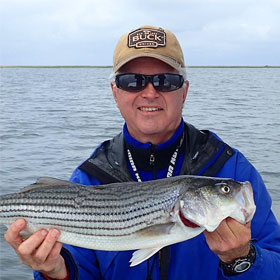There Are Many Benefits to Using Braided Fishing Line
By Ken Schultz
Mar 05, 2021
The low diameter, low stretch, and limpness of braided fishing line produces a long list of benefits for casting, hooksetting, lure retrieval, and landing fish
The term “braided fishing line” (or simply “braided line”) refers to a modern product made from woven synthetic material and which has great strength with low diameter. They were first called “superlines” because they came from incredibly strong yet thin gel-spun polyethylene fibers. A century or more ago there were braided fishing lines made from woven cotton or linen; they were bulky, hard to use, deteriorated easily, and immediately became virtual relics when nylon fishing line was introduced. The latter were called monofilament (single strand), as opposed to the multi-filament construction of braided fishing lines.
The Most Important Characteristics
Low Diameter
These lines are far thinner than other comparable-strength monofilament lines.
Low Stretch
Braided fishing lines have little to no stretch, unlike monofilament lines, which can vary significantly in the amount of stretch that occurs under severe pressure.
Limpness
These fishing lines are supple, not wiry, and don’t have retained memory like nylon products.
The Most Important Benefits
- Good casting performance due to limpness, thinness, and less chance of twisting
- Ability to achieve greater casting distance with thin-yet-strong line
- Ablity to get certain lures (jigs and trolled plugs, for example) deeper
- Ability to spool greater lengths on a fishing reel
- Ability to spool a significant amount of line on a smaller reel than you can with other lines
- Ability to cut through some types of underwater aquatic plants when playing a strong fish
- Enhanced strike detection due to excellent sensitivity
- Enhanced ability to feel debris on a line, hook, or lure
- Enhanced ability to feel the action of certain types of lures (especially those with vibration qualities)
- Greater hookup potential due to lack of stretch
- Enhanced ability to turn strong fish way from obstructions/cover/objects
Other Potential Benefits
- Depending on fishing circumstances and on how you care for your tackle, braided fishing lines may be more durable and longer lasting than other lines.
- Depending on how well you tie knots, and whether you use the proper ones, braided line can hold knots as well or better than other fishing lines. The Palomar Knot may be the most popular of braided fishing line knots, followed by the Uni. With braided line I exclusively use a single Uni Knot for terminal connections, and the Line-to-Line Uni Knot for connecting two lines or making a leader-to-line connection.
- Manufacturers and many anglers tout the abrasion resistance of braided line, but I know of no test that proves this in actual fishing conditions. While I wouldn’t say it’s worse than monofilament, my experience is that it is not necessarily better.
A one-time monofilament-only line user, I now do roughly 70 percent of my fishing with braided fishing lines because of the benefits noted. There are some minor drawbacks (they’re more expensive, harder to cut, may produce wind knots, and are prone to rod-tip fouling), and types of fishing where other lines are more appropriate. Nevertheless, braided fishing lines do help anglers be more productive.









